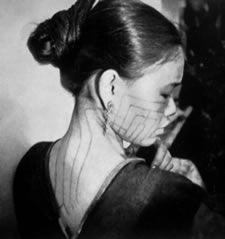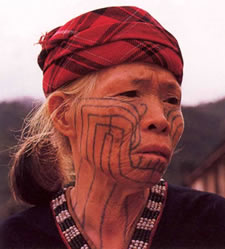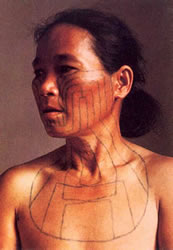Wen Shen: The Vanishing Art of Chinese Tribal Culture
Article © 2009 Lars Krutak
Tattooed Peoples at The Tail of the Dragon
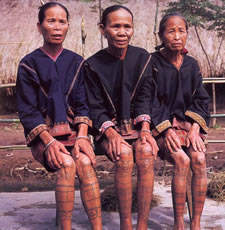 |
|
Li body
tattoos of the Run tribe, ca. 1988. |
Today as in the past, the Li practice an
animism-based religion focusing on ancestor
and nature worship. They believe every
object in their visible and invisible
universe has its own soul and is immortal.
Rocks are especially powerful in this
regard, because they are the "houses" for
the God of the Earth and in almost every
village there are shrines filled with rocks
of all shapes and sizes. Mountains too have
spirits, especially the sacred Five Finger
Mountain, and one explorer commented in the
1930s upon its ascent that "we must not talk
aloud or cough violently, lest the mountain
spirits be disturbed. Crying would not be
allowed. We must not look back either in
ascent or in descent. Failure to observe
these rules would result in some unthinkable
misfortune, such as attacks by evil spirits
or by poisonous snakes and other fierce
animals."
It is believed that the Li came to Hainan from mainland China, but an
obscure origin myth collected in the 1930s states that the "Father" of
all Li came from central Vietnam. This origin myth, stated below, is
important because it can be linked to the avian origin of the Li's
custom of tattooing which I will relate a bit later.
"To the west of the city of Chiung-chou stood formerly the Li
Mother Temple. The Spirit of Thunder carried an egg into the Li
Mother Mountain (the next in height to the sacred Five Finger
Mountain in the center of the island) from which a woman was
produced. A man from Kao-chi (Annam or Vietnam) crossed the sea to
Hainan in search of fragrant herbs. He encountered the woman and
married her. From the marriage of these two, children and
grandchildren sprang in great numbers. This woman was the Li Mother.
Originally, the Li belonged to the race of birds and beasts. Being
derived from eggs, their natural disposition was distinct from that
of human beings, so that from ancient times to the present they have
remained influenced by nature."
According to German ethnologist Hans
Stϋbel, the origin of Li tattooing or tatan
also lay in bird-lore:
The progenitor of the Li had a daughter, whose mother died
shortly after the birth of this child. Whereupon a hoopoe (Upupa
epos) fed the child with grains. In remembrance, the Li women still
tattoo themselves in order to appear to be as colorful as birds.
Perhaps the tattoos represent the pattern on the wings of the
hoopoes."
Other writers have offered a different
set of stories to explain the indelible
customs of the Li. First, that the ancestors
of the Li practiced tattooing in order to
easily recognize their descendents in the
afterlife. And secondly:
"Once upon a time when a mother and her son were the only
survivors of a great deluge, the former disguised herself by tattoo
marks from being recognized by her son at God's bidding in order
that the earth might be repeopled."
The Li tattoo kit consisted of a sharp rattan needle set into a
bamboo rod that was hand-tapped into the skin with another wooden
implement. The tattoo pigment was extracted from natural indigo (Baphicacanthus
cusia) or the Barbados nut (Jatropha curcas), and the tattoo patterns
were first stenciled on the skin before being punctured into the
epidermis by the tattooist who was female. The wounds took several days
to heal.
The patterns adopted by Li women differed considerably from tribe to
tribe according to their ancestral traditions. They are said to be
designs taken from nature like various plants, animals, and totemic clan
symbols passed down through the generations.
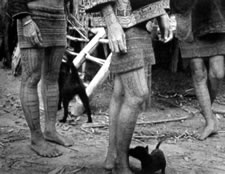 |
|
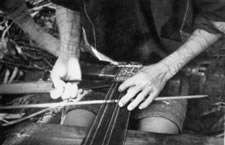 |
|
Li hand and
leg tattoos of the Run tribe, ca.
1930. It has been said that it was
not appropriate for a Li woman to
have her hands tattooed until she
was married. Li tattooing was more
popular among women than men. In
cases of the latter, males tattooed
three simple blue rings around their
wrist for medicinal purposes |
|
Tattooed Li
woman of the Run tribe weaving a tubeskirt with backstrap loom, ca.
1930. As early as the first century
B.C., it was recorded that Li women
produced homespun cotton which was
then dyed and woven into immaculate
garments. During the Qing Dynasty,
Li brocade was considered to be "as
fascinating as clouds,"
incorporating birds, insects,
animals, flowers, stars and other
celestial objects into exquisite
designs. Many of these motifs, all
of which were derived from nature,
can be traced to tattoo patterns
that only a few elderly women wear
today. |
If a girl was to be married to a member
of another group, the pattern used was not
that of her tribe but that of the bridegroom
who sent it to the bride's family before the
tattooing took place. One writer for the
National Geographic Magazine in the 1930s
stated you could "read the village, social
standing, and identity" through a woman's
tattoos. Her woven textiles supposedly
imparted similar information.
Next Page
|
1 | 2 |
3
|
4
|
5
|


